VII.1.25
Pompeii. Casa dei Principi di Russia, Second entrance to VII.1.47 House of
Siricus.
Linked to VII .1.46. Excavated
1851, 1857, 1862, and 1872. Restored and reopened 2017.
(Strada Stabiana 57).
Part 1 Part 2 Part 3 Combined plan of VII.1.25 VII.1.47 and VII.1.46 VII.1.47 VII.1.46
![VII.1.25 Pompeii. c.1915 photo. Looking west across atrium 24 through peristyle 31 to exedra 33. Photo courtesy of Rick Bauer.
According to Breton [1855], a large doorway gives entry to the large peristyle of 14 m 10 and 11 metres deep; It was supported by ten columns, which still carry a fragment of entablature. In the right corner is a recess, a kind of cabinet, where we found a few small terracotta vases. The walls of the peristyle were decorated with alternately red and yellow panels with figures of Diana, of Leto, of Victories, Bacchae, etc. Right at the bottom of the peristyle are a triclinium where are the weak remnants of two Geniuses and a greyhound and in the middle, a small oecus preceded by two ornate pillars of rich arabesques of a style a lot less light than in other buildings in Pompeii. On the left wall was a mediocre but interesting painting of the subject in which Mr. Minervini recognized Alcmaeon killing his mother Eriphyle; this painting has been removed [to the Naples Museum]. Finally to the left of the oecus, in a small room, are several heads in medallions and three paintings, Venus and Adonis, Diana and Endymion, and a scene in which the same scientist saw Orestes and Pylades recognized by Iphigenia, and thinking how to flee from Tauris; we thought ourselves that it was probably Leda and the Dioscuri, a subject that seemed more in relation to the mythological compositions that surround it; today a further assumption is issued by Mr. Ed. Brizio; the absence of heroic costume, the hue of realism that dominates in this composition made him think that the seated figure that he took for a woman is something else, that of a magistrate dressed in gown listening to two litigants, and Mr. Minervini agreed with this opinion.
See Breton, Ernest. 1855. Pompeia, décrite et dessine : Seconde édition. Paris, Baudry, p. 316.](7%2001%2025%20p2_files/image002.jpg)
VII.1.25 Pompeii. c.1915 photo. Looking west across atrium 24 through peristyle 31 to exedra 33. Photo courtesy of Rick Bauer.
According to Breton [1855], a large doorway gives entry to the large peristyle of 14 m 10 and 11 metres deep; It was supported by ten columns, which still carry a fragment of entablature. In the right corner is a recess, a kind of cabinet, where we found a few small terracotta vases. The walls of the peristyle were decorated with alternately red and yellow panels with figures of Diana, of Leto, of Victories, Bacchae, etc. Right at the bottom of the peristyle are a triclinium where are the weak remnants of two Geniuses and a greyhound and in the middle, a small oecus preceded by two ornate pillars of rich arabesques of a style a lot less light than in other buildings in Pompeii. On the left wall was a mediocre but interesting painting of the subject in which Mr. Minervini recognized Alcmaeon killing his mother Eriphyle; this painting has been removed [to the Naples Museum]. Finally to the left of the oecus, in a small room, are several heads in medallions and three paintings, Venus and Adonis, Diana and Endymion, and a scene in which the same scientist saw Orestes and Pylades recognized by Iphigenia, and thinking how to flee from Tauris; we thought ourselves that it was probably Leda and the Dioscuri, a subject that seemed more in relation to the mythological compositions that surround it; today a further assumption is issued by Mr. Ed. Brizio; the absence of heroic costume, the hue of realism that dominates in this composition made him think that the seated figure that he took for a woman is something else, that of a magistrate dressed in gown listening to two litigants, and Mr. Minervini agreed with this opinion.
See Breton, Ernest. 1855. Pompeia, décrite et dessine : Seconde édition. Paris, Baudry, p. 316.

Source: The Wilhelmina and Stanley A. Jashemski archive in the University of Maryland Library, Special Collections (See collection page) and made available under the Creative Commons Attribution-Non-Commercial License v.4. See Licence and use details.
J66f0383
According to Fiorelli –
At the rear of the atrium was the door that led into the peristyle, of which the front walkway served perhaps as a tablinum.
On the walls of this portico, were noted:
On the right, various indeterminate figures and a bacchante:
On the left, a naval Vittoria, Diana, Leto and another Vittoria bearing a sword:
In front facing, a bacchante:
And in the Frieze,
birds, gorgons’ heads, baskets hanging from ribbons, quadrupeds, and other
decorations. In the middle was the garden
(“Nel
fondo dell’atrio eravi la porta che immetteva nel peristilio, di cui
l’ambulacro anteriore serviva forse di tablino. Sulle pareti di questo portico
si notavano:
a
destra varie figure indeterminate ed una Baccante:
a
sinistra, una Vittoria navale, Diana, Latona, ed altra Vittoria recante una
spada:
di
fronte, una Baccante:
e
nel fregio uccelli, teste gorgoniche, cesti pendenti da nastri, quadrupedi, ed
ornati diversi. Stava nel mezzo il giardino.”)
See Pappalardo, U., 2001. La Descrizione di Pompei per Giuseppe Fiorelli (1875). Napoli: Massa Editore. (p.76)

VII.1.25 Pompeii. September
2017.
Looking
south-west across peristyle 31, through doorway from atrium 24. Photo courtesy
of Klaus Heese.

VII.1.25 Pompeii. September 2017. Peristyle 31, puteal.
Photo courtesy of Klaus Heese.

Looking south-west across peristyle 31 towards rear rooms. Photo courtesy of Rick Bauer.


VII.1.25
Pompeii. April 2018. Looking north-west across peristyle 31. Photo courtesy of
Ian Lycett-King.
Use
is subject to Creative Commons Attribution-NonCommercial
License v.4 International.

VII.1.25
Pompeii. April 2018. Looking north-west across peristyle 31, from east side.
Photo courtesy of Ian Lycett-King.
Use
is subject to Creative Commons Attribution-NonCommercial
License v.4 International.
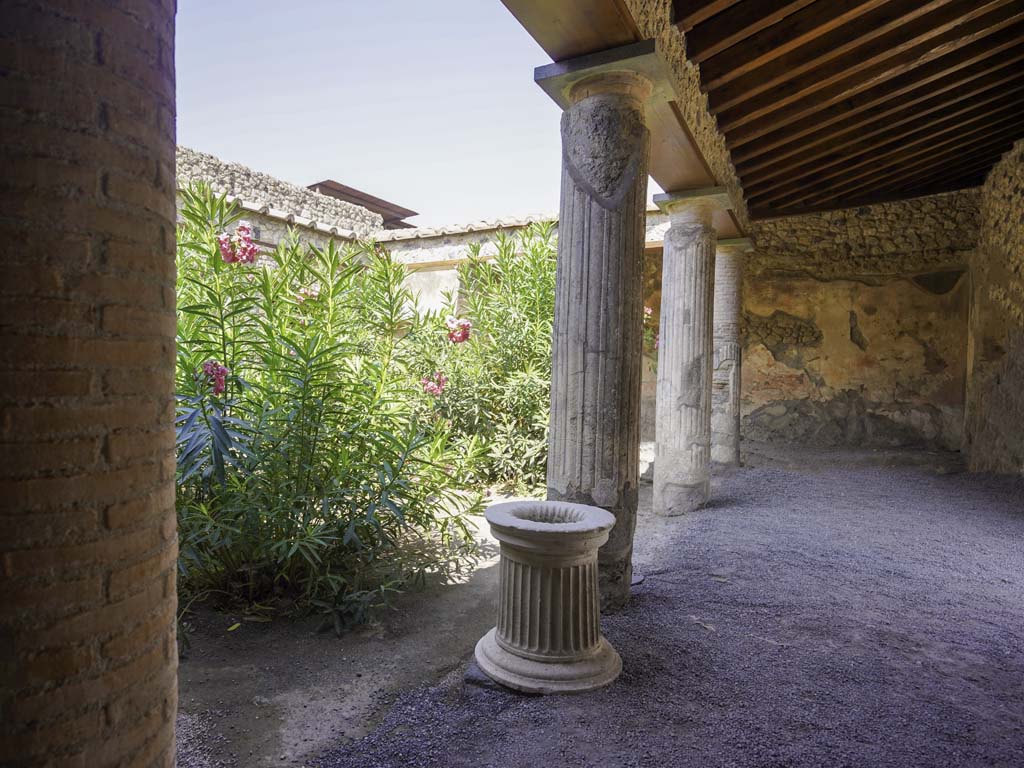
VII.1.25
Pompeii. August 2021. Peristyle 31, looking towards north wall. Photo courtesy
of Robert Hanson.
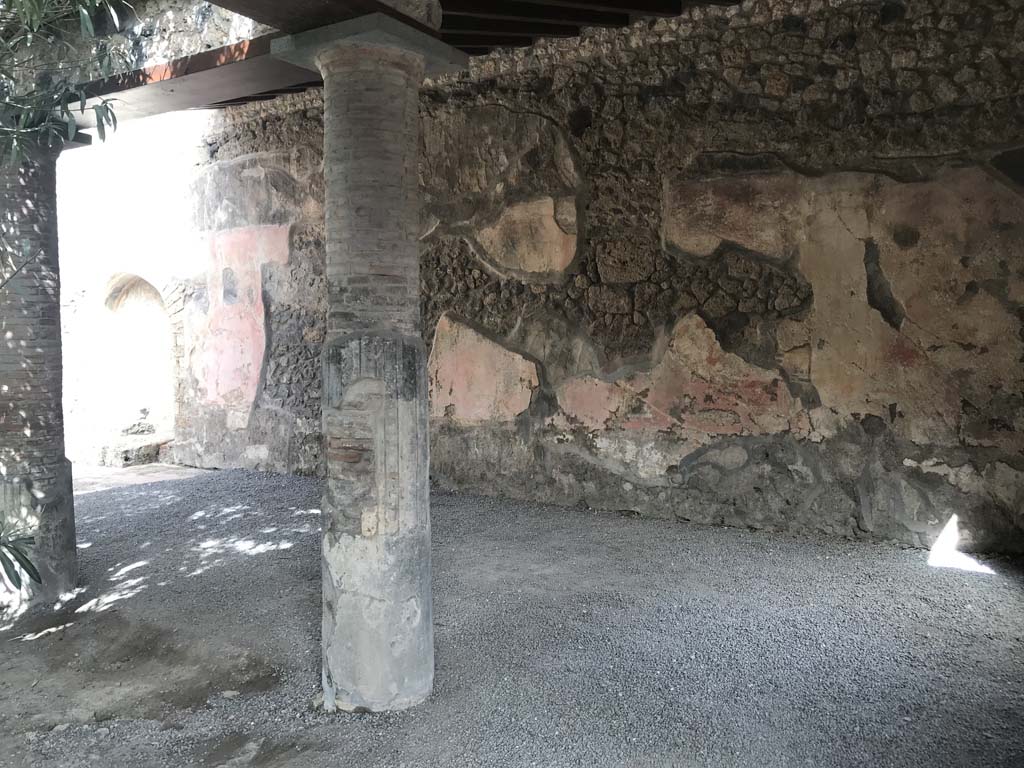
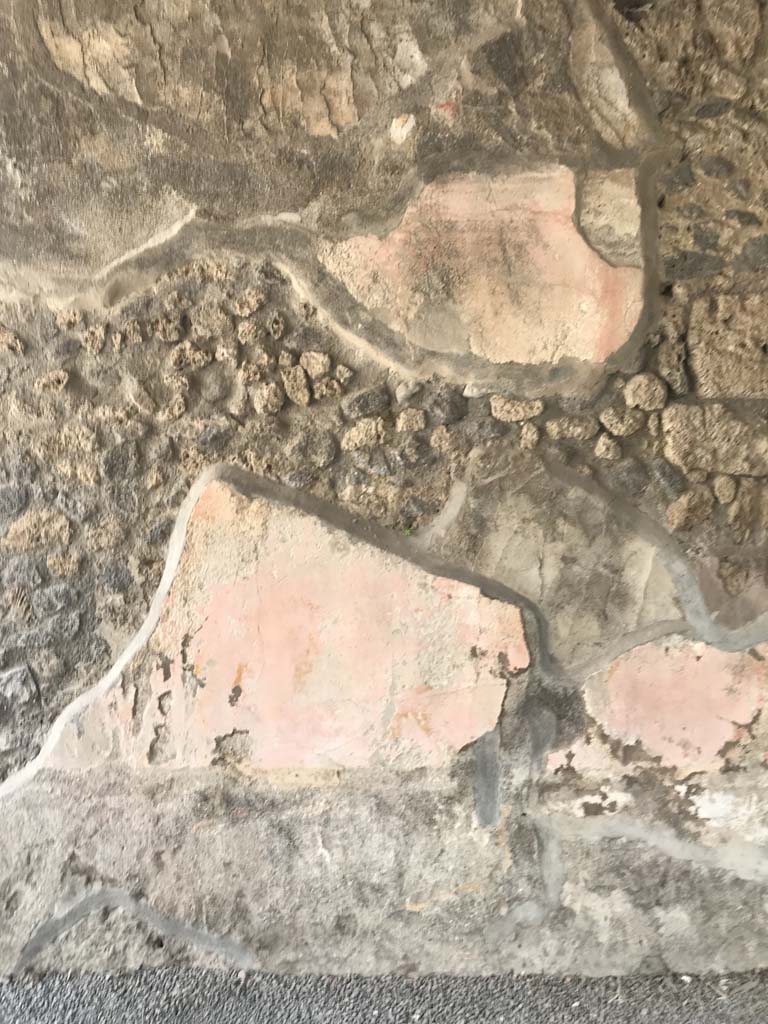
VII.1.25 Pompeii. April 2019. Peristyle 31, detail of north wall. Photo courtesy of Rick Bauer.
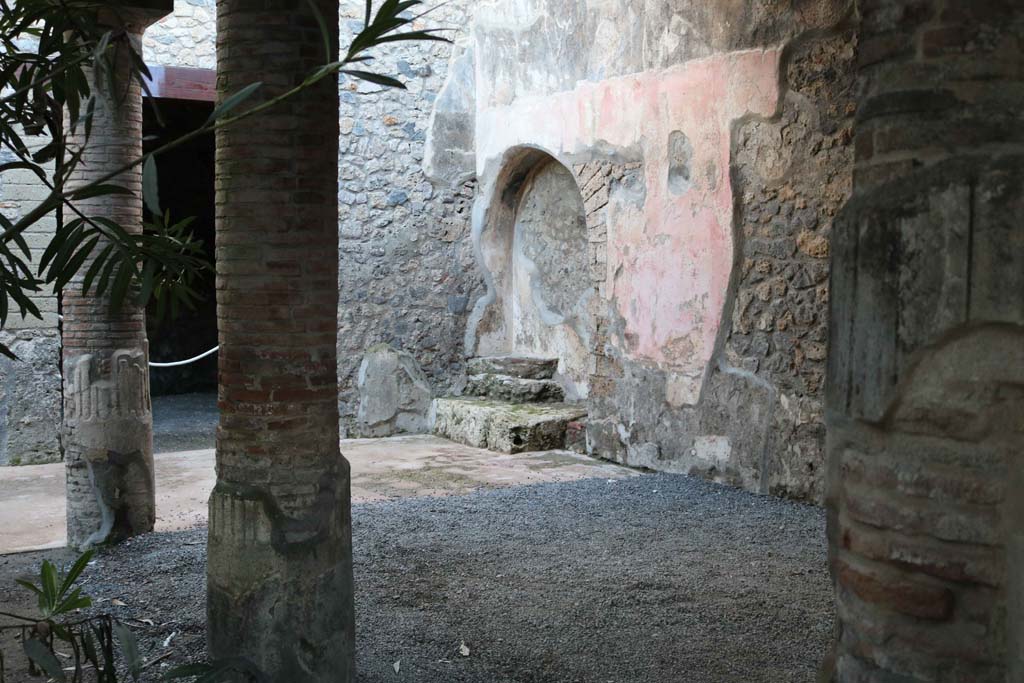
VII.1.25 Pompeii. December 2018. Peristyle 31, looking
towards north-west corner. Photo courtesy of Aude Durand.
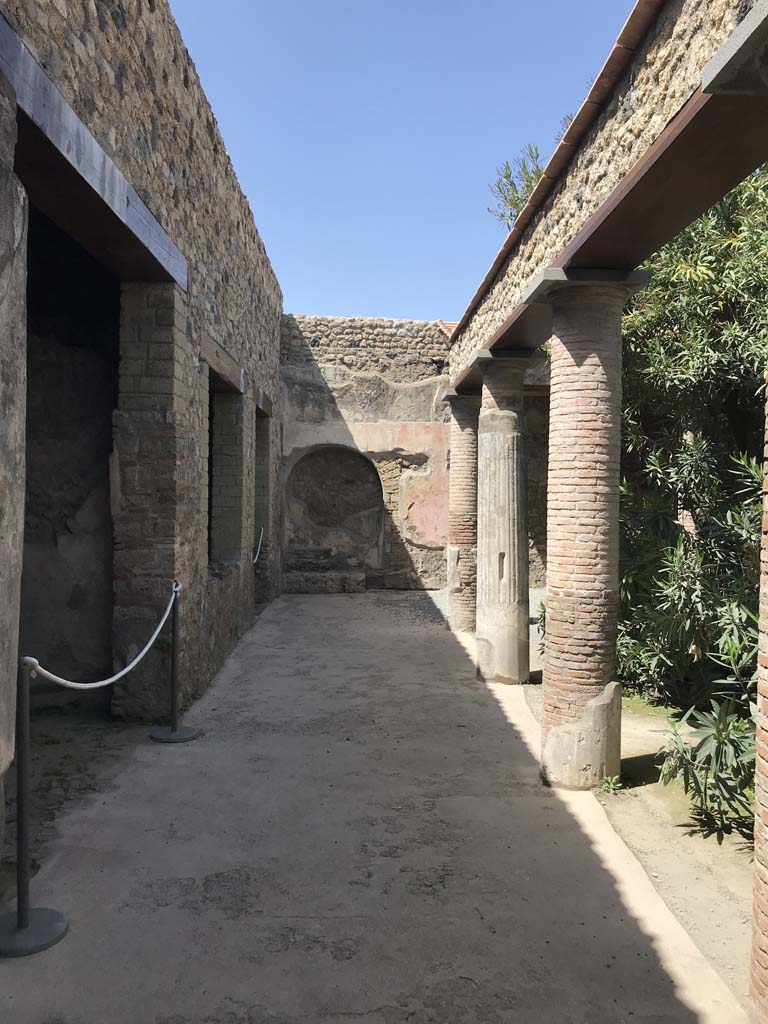
VII.1.47/25 Pompeii. April 2019. North-west corner of peristyle 31.
Looking north across west side of peristyle 31, from steps up from peristyle 19.
On the left is the open doorway to Exedra 33, followed by the window and doorway to Triclinium 32.
Photo courtesy of Rick Bauer.
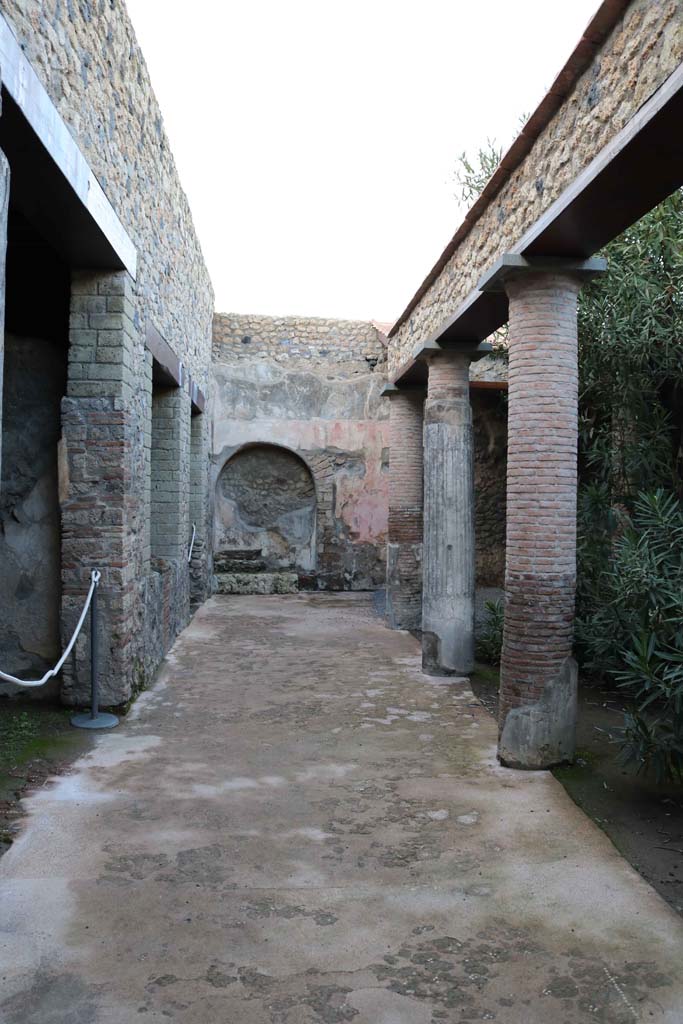
VII.1.25 Pompeii. December 2018. Looking north across west side of peristyle 31.
On the left is the open doorway to Exedra 33, followed by the window and doorway to Triclinium 32.
Photo
courtesy of Aude Durand.
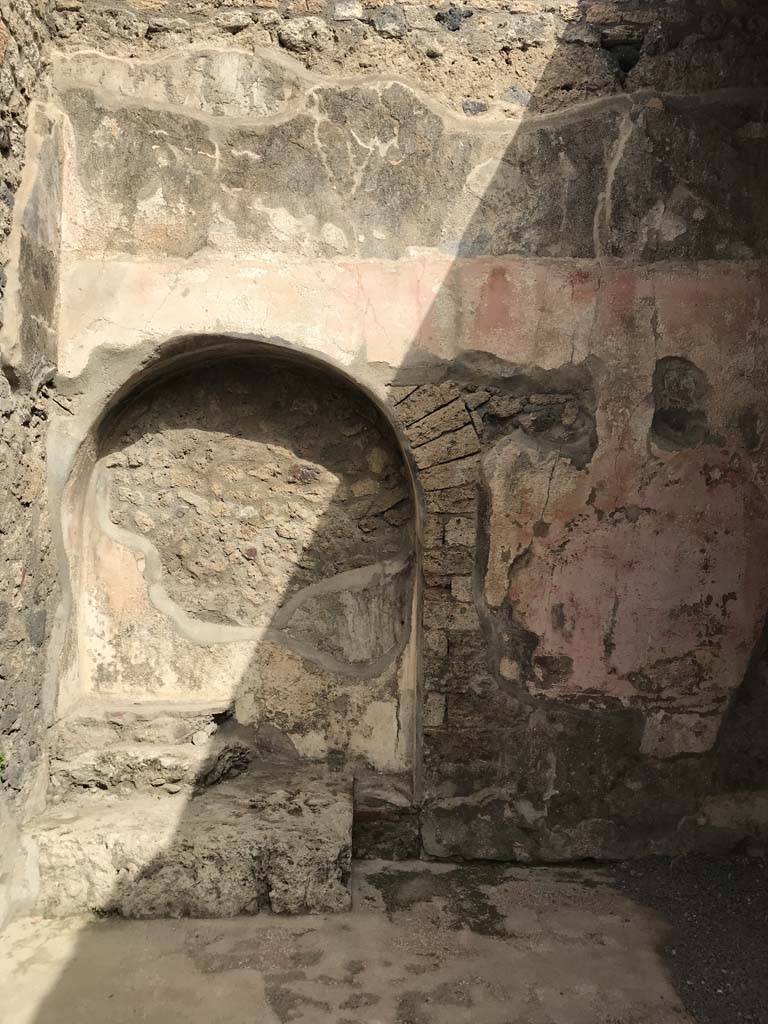
Peristyle 31, arched recess in north-west corner. Photo courtesy of Rick Bauer.
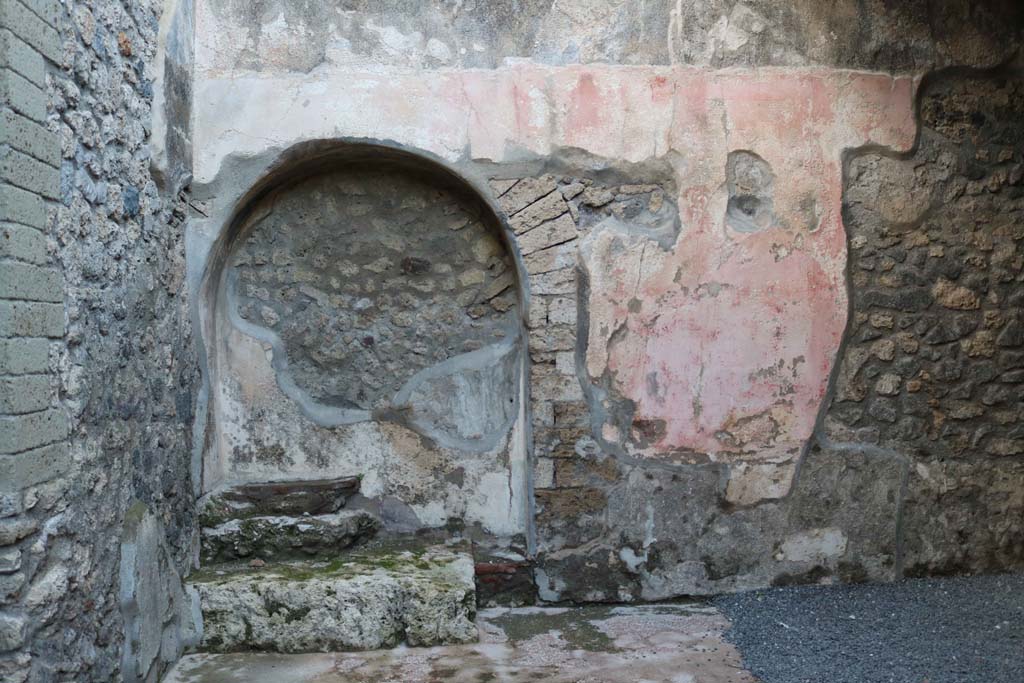
VII.1.25
Pompeii. December 2018. Peristyle 31, north-west corner with arched
recess. Photo
courtesy of Aude Durand.

VII.1.25 Pompeii. April 2018. Looking north along west side of peristyle
31, towards large recess/niche in north-west corner.
Photo courtesy of Ian Lycett-King. Use is subject to Creative
Commons Attribution-NonCommercial License v.4 International.

VII.1.25 Pompeii. May 2017. Large niche/recess on north side of peristyle 31, in north-west corner.
On the left is the window and doorway of room 32. Photo courtesy of John Puffer.
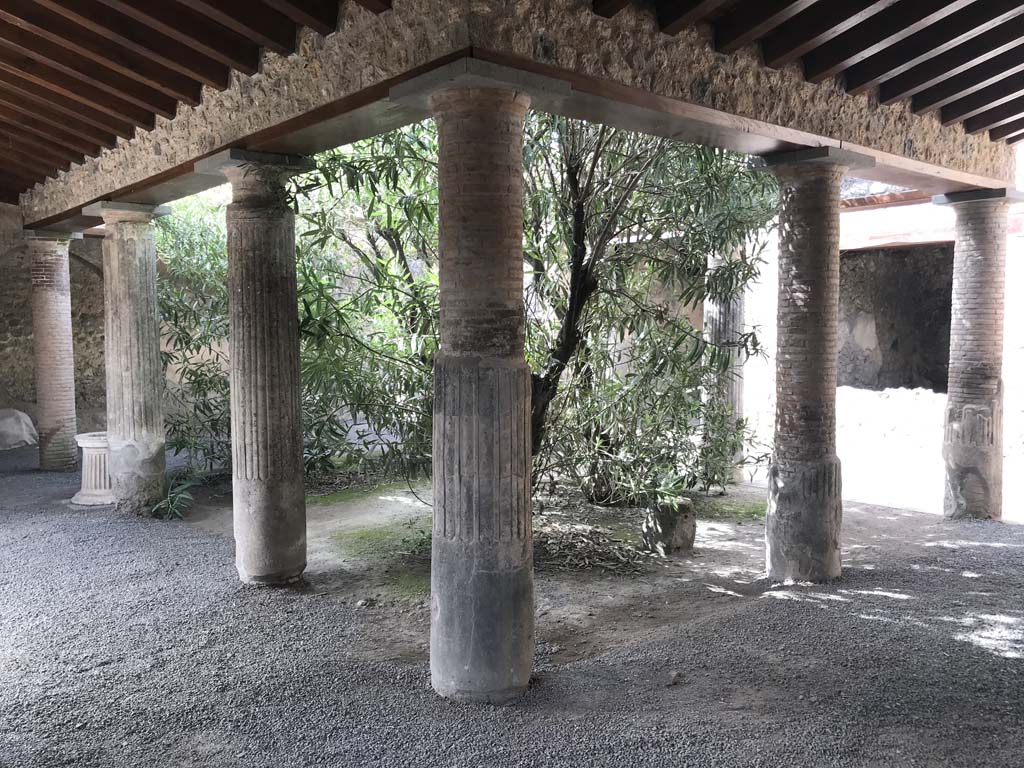
Looking south-west across peristyle 31, with window to Triclinium 32, on right. Photo courtesy of Rick Bauer.
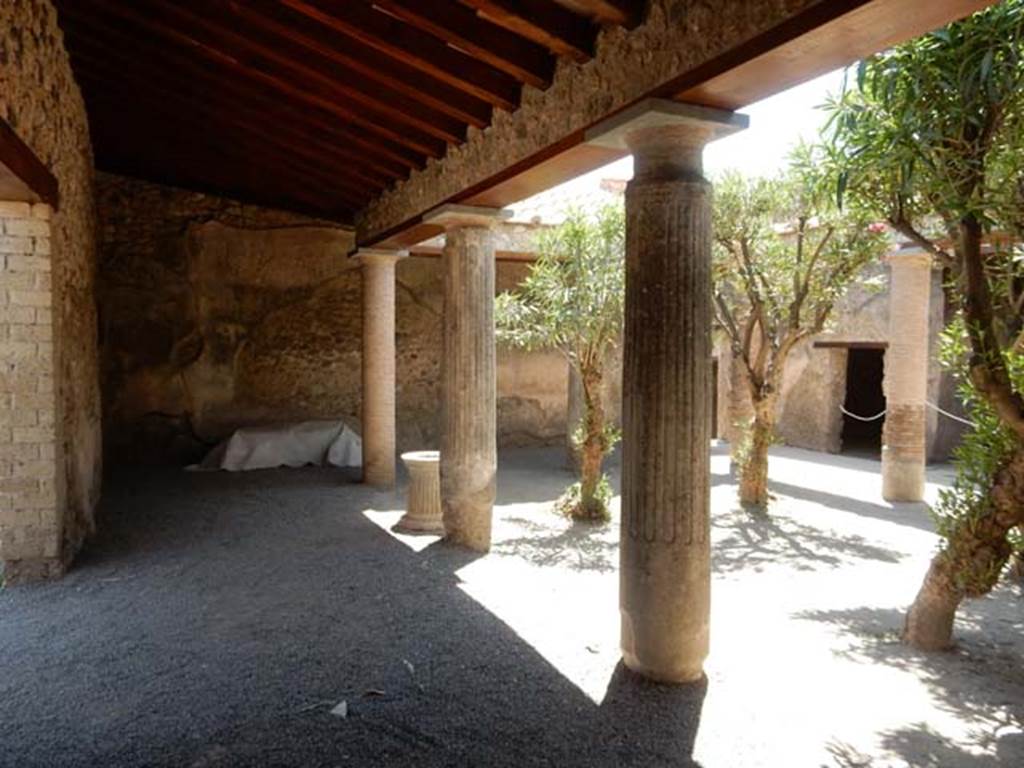
VII.1.25 Pompeii. May 2017. Looking south across peristyle 31 after restoration and with new roof. Photo courtesy of Buzz Ferebee.
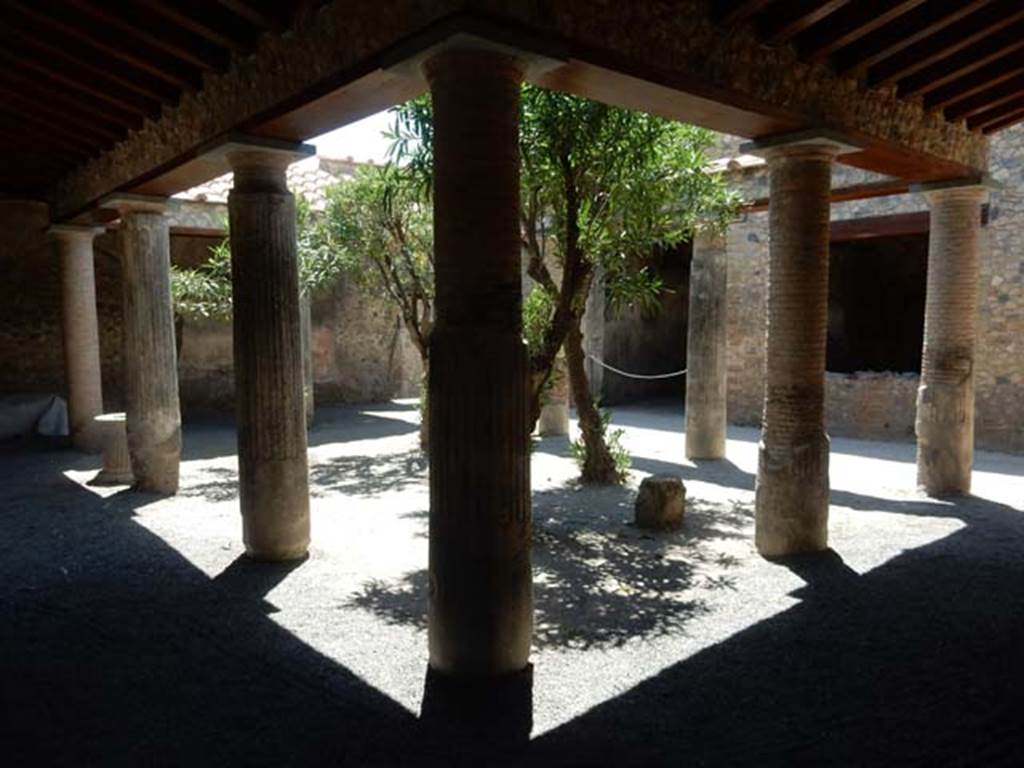
VII.1.25 Pompeii. May 2017. Looking south-west across peristyle 31.
On the west side of the peristyle are three rooms, a cubiculum 34, an exedra 33 and a windowed triclinium 32.
Photo courtesy of Buzz Ferebee.
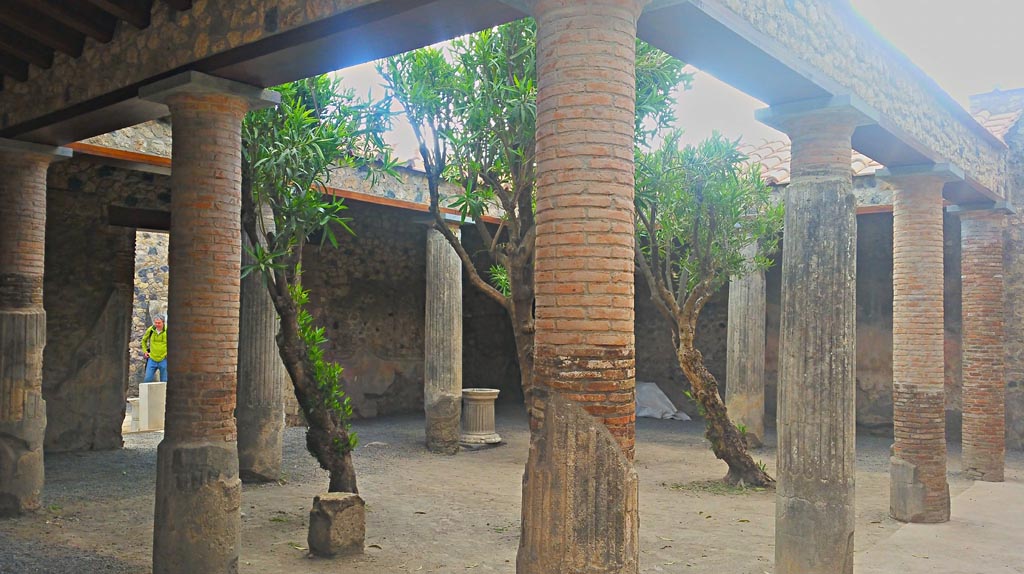
VII.1.25 Pompeii. May 2017. Looking east across peristyle 31, with doorway to atrium, on left. Photo courtesy of Giuseppe Ciaramella.
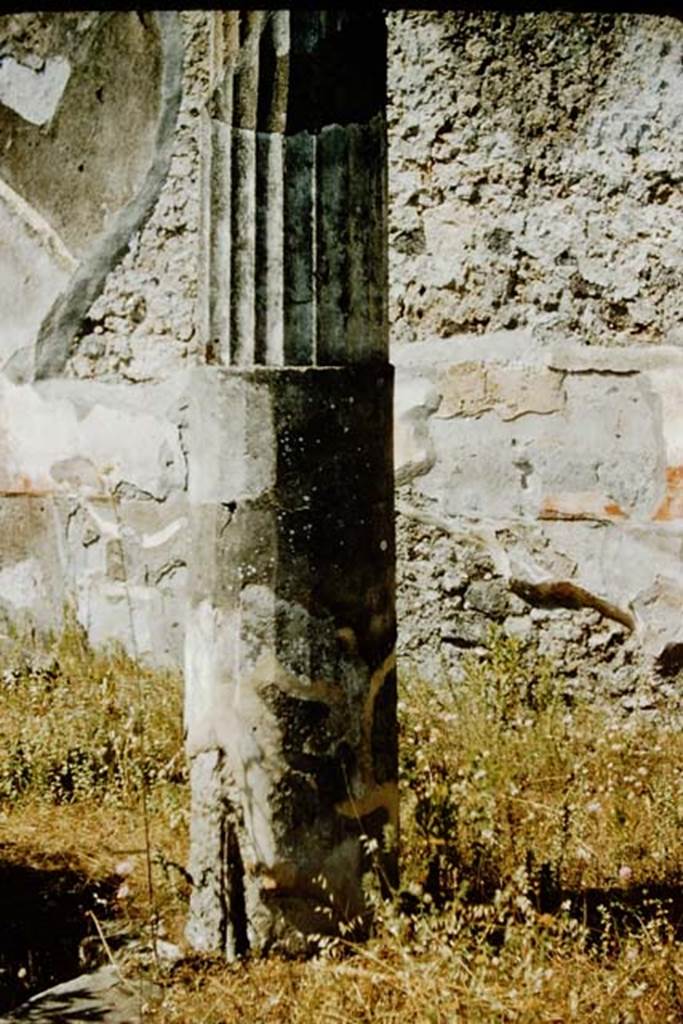
VI.1.25 Pompeii. 1957. Column in peristyle 31. Photo by Stanley A. Jashemski.
Source: The Wilhelmina and Stanley A. Jashemski archive in the University of Maryland Library, Special Collections (See collection page) and made available under the Creative Commons Attribution-Non-Commercial License v.4. See Licence and use details.
J57f0122
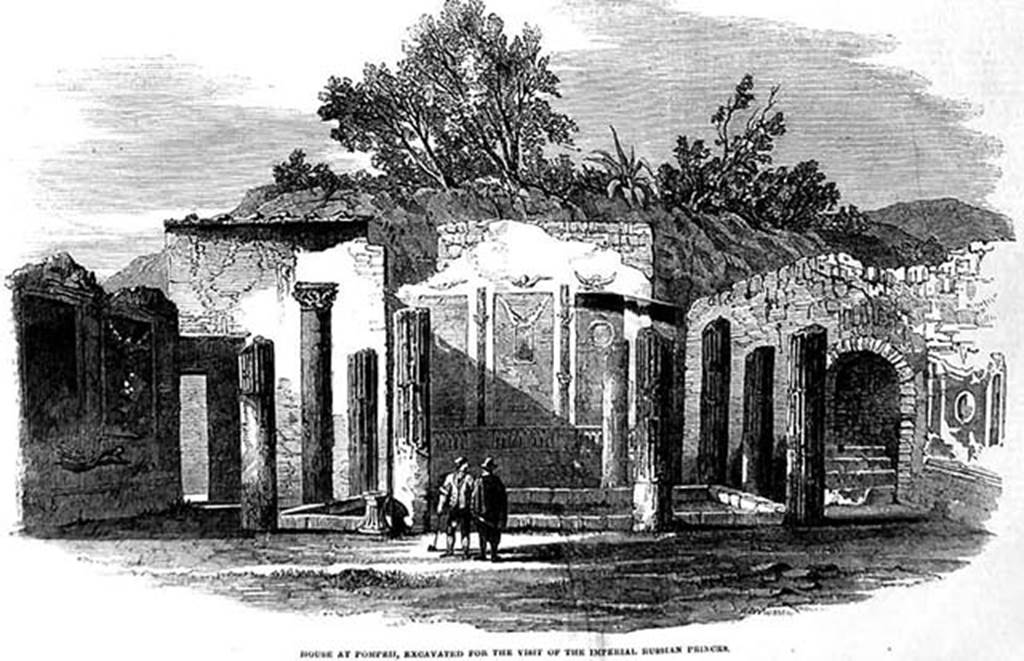
VI.1.25 Pompeii. 1853.
Drawing titled House at Pompeii excavated for the visit of the Imperial Russian Princes. Photo courtesy of Drew Baker.
See The Illustrated London News, 30th April 1853, p. 329.
On the 14th April from Naples our own correspondent reported that
“As we entered the Stabian Street we observed on either side a series of dwellings, ………… We next proceeded to the most important house yet found in this street, and which had been lately excavated for the Imperial Princes of Russia (See Illustration). You enter a wide portico of the ostiarius, paved with marble, where an elegant table of the same material is placed. The clawed legs of this table are carved with fruits, and the form is very elegant. You then come upon the atrium, with the usual impluvium. None of the surrounding columns is perfect; and only one of the capitals was found, which is rather grotesque than classical. The circular object near one of the columns is a Well, fluted all round, the rim of which bears traces of having been much used. The alae or wings of this dwelling occur at the further end. The centre room is large and might have been used as a triclinium. It is decorated with those floral romances and architectural illusions which glitter brightly on the walls of Pompeii. This room opens into two smaller apartments – one on the left, and one on the right – nearly destroyed. The main wall on the right contains a niche with steps, but no statue was found. The present dwelling, like most of the houses of Pompeii, had evidently been well rifled by the ancients. Some copper kitchen utensils and a few unimportant marble decorative garden sculptures are all that was found in a dwelling of so much importance. *”
Footnote:
* “The small objects found at Pompeii are always removed to the Museum of Naples. Up to the present time no attempt has been made to restore a house and furnish it, although so much material exists for so doing.”
According to Breton many of the roof tiles contained the name of the maker N. Sabinus.
See Breton, Ernest. 1855. Pompeia, décrite et dessine: Seconde édition. Paris, Baudry, p. 317.
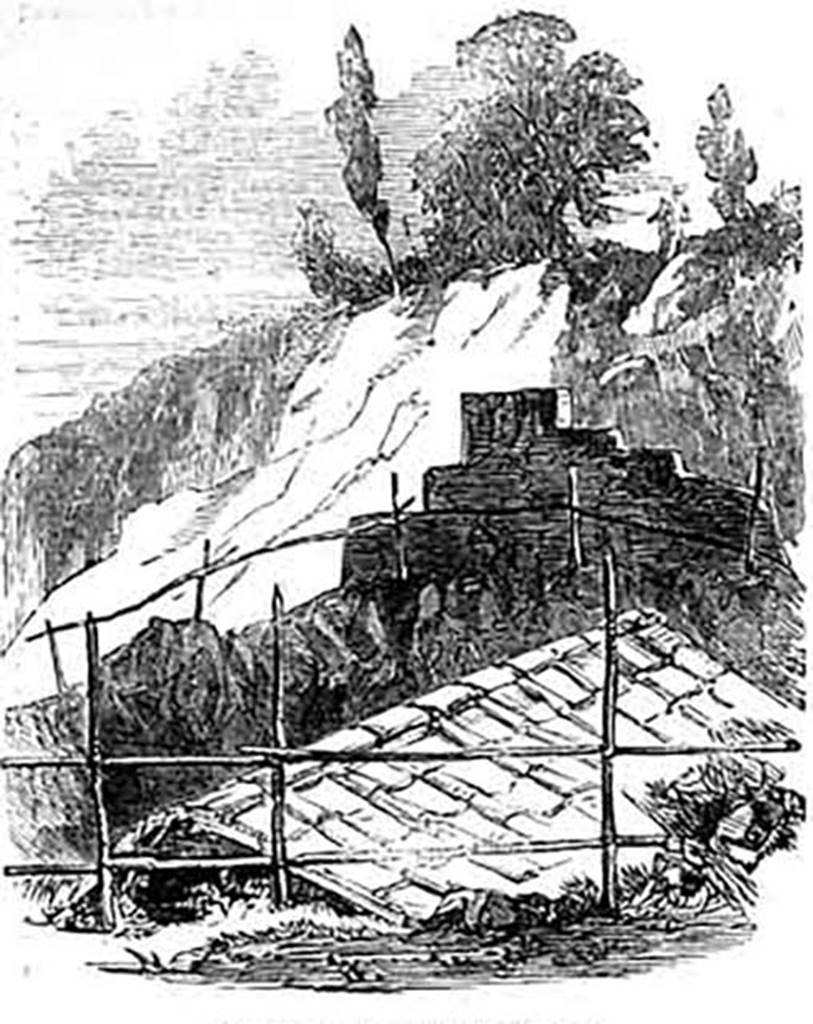
VI.1.25 Pompeii. 1853.
Drawing titled Roof Excavation Near the Gate of Stabia. Photo courtesy of Drew Baker.
On the 14th of April from Naples our own correspondent reported that “Threading our way through the back doorway of this house, we came upon the most remarkable discovery which has yet taken place, viz., the complete roofing of a house, of which I send you a drawing. It will be remembered that Pompeii having been destroyed by falling ashes, and then covered by earth, was the occasion of the roofs falling in. The very little care used in clearing away the incumbent earth has left us in the dark about the construction of ancient roofings. Here, then, for the first time, we have a complete roof of a house formed of square tiles, about twelve inches by twelve, with coping tiles running between them; and over the back-bone, so to speak, of the construction, a cement was used to make the roofing water-tight. So perfect is the roof, that it might have been constructed yesterday, and it would suit an English cottage.”
See The Illustrated London News, 30th April 1853, p. 329.
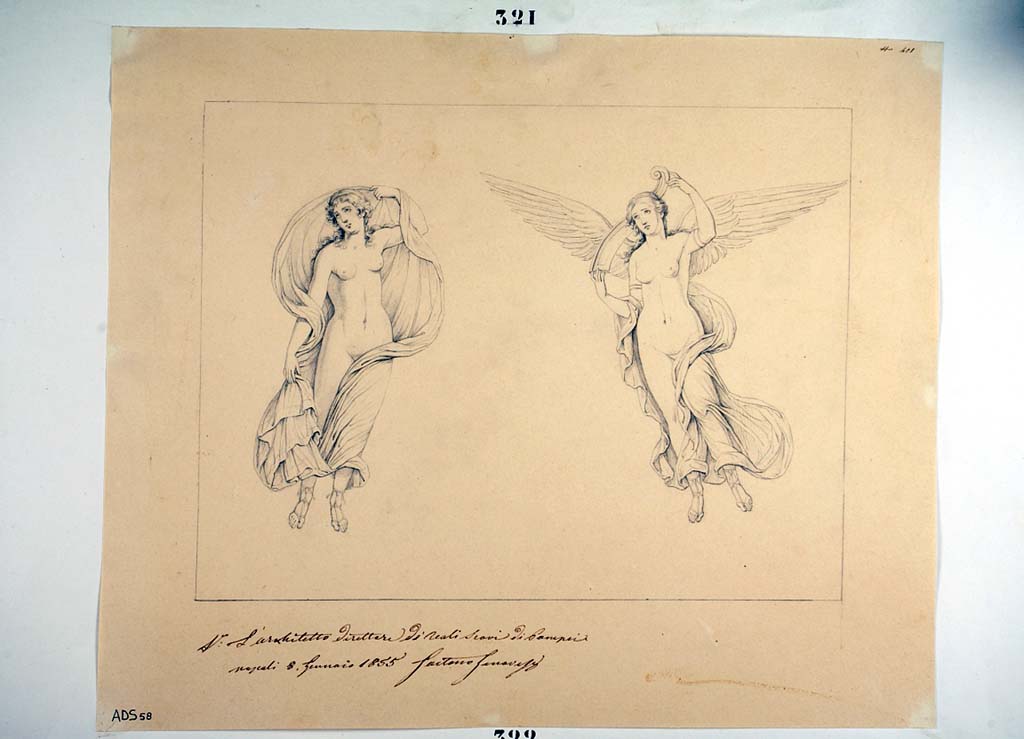
VI.1.25 Pompeii. Peristyle 31. Panel with female figures, 1855, attributed to Nicola La Volpe.
The figure on the right, Vittoria with rudder on her shoulder, would have been seen on the south wall of peristyle 31.
See Helbig, W., 1868. Wandgemälde der vom Vesuv verschütteten Städte Campaniens. Leipzig: Breitkopf und Härtel, (914).
The figure on the left might be provenanced from Casa del Citarista, I.4.5/25.
Now in Naples Archaeological Museum. Inventory number ADS 58.
Photo © ICCD. https://www.catalogo.beniculturali.it
Utilizzabili alle
condizioni della licenza Attribuzione - Non commerciale - Condividi
allo stesso modo 2.5 Italia (CC BY-NC-SA 2.5 IT)
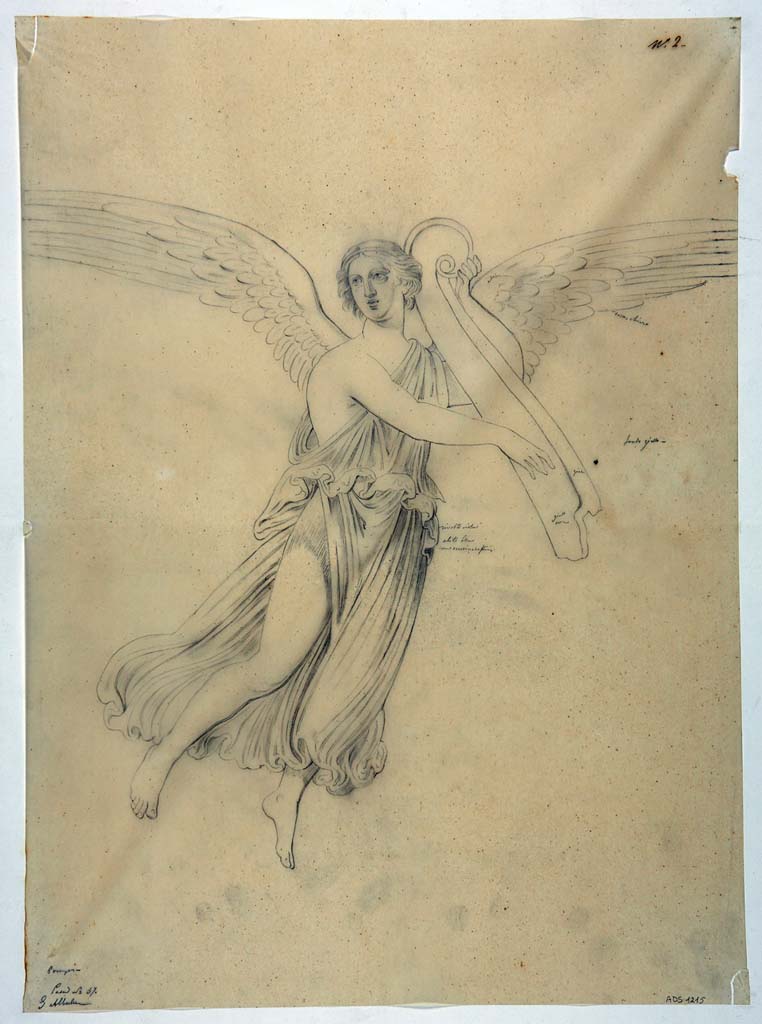
VI.1.25 Pompeii. Drawing by Giuseppe Abbate, of Nike with rudder on shoulder provenanced
from south wall of peristyle 31.
No trace of
painting remains.
See Helbig, W., 1868. Wandgemälde der vom Vesuv verschütteten Städte Campaniens. Leipzig: Breitkopf und Härtel, (914).
Now in Naples Archaeological Museum. Inventory number ADS 1215.
Photo © ICCD. https://www.catalogo.beniculturali.it
Utilizzabili alle
condizioni della licenza Attribuzione - Non commerciale - Condividi
allo stesso modo 2.5 Italia (CC BY-NC-SA 2.5 IT)
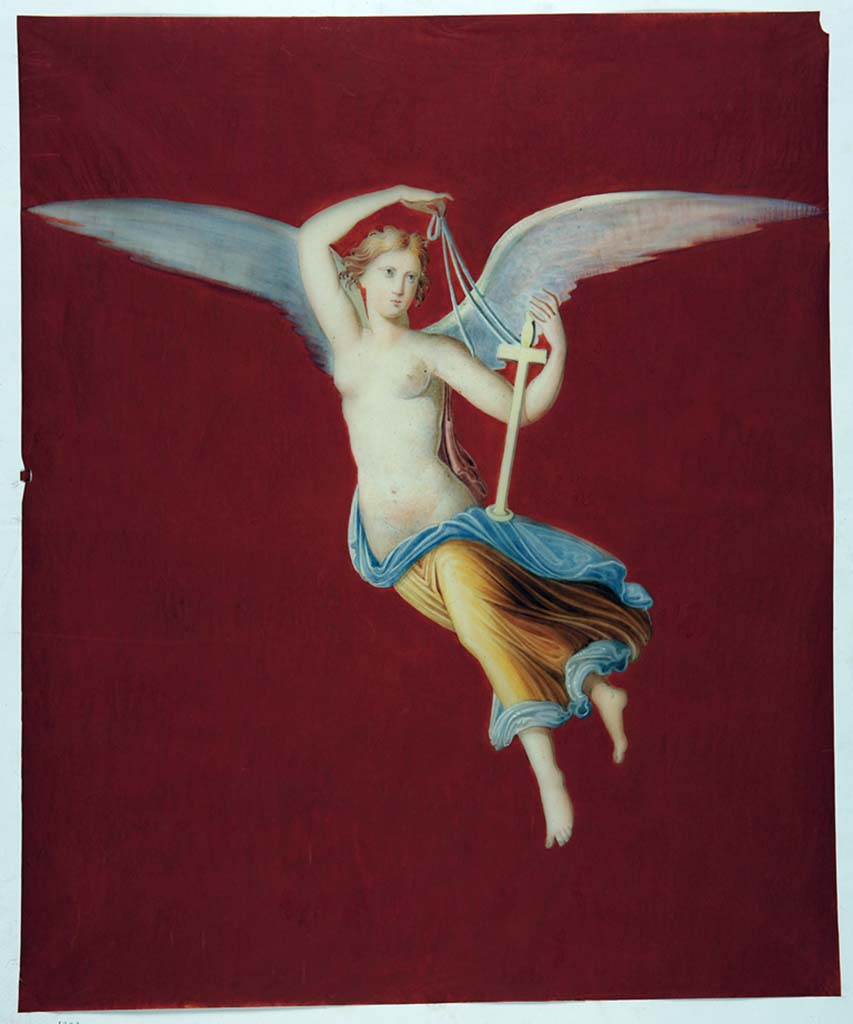
VI.1.25 Pompeii. Painting attributed to Giuseppe Abbate, of Vittoria with sword,
provenanced from south wall of peristyle 31.
Now in Naples Archaeological Museum. Inventory number ADS 1223.
Photo © ICCD. https://www.catalogo.beniculturali.it
Utilizzabili alle
condizioni della licenza Attribuzione - Non commerciale - Condividi
allo stesso modo 2.5 Italia (CC BY-NC-SA 2.5 IT)
See Helbig, W., 1868. Wandgemälde der vom Vesuv verschütteten Städte Campaniens. Leipzig: Breitkopf und Härtel, (911).
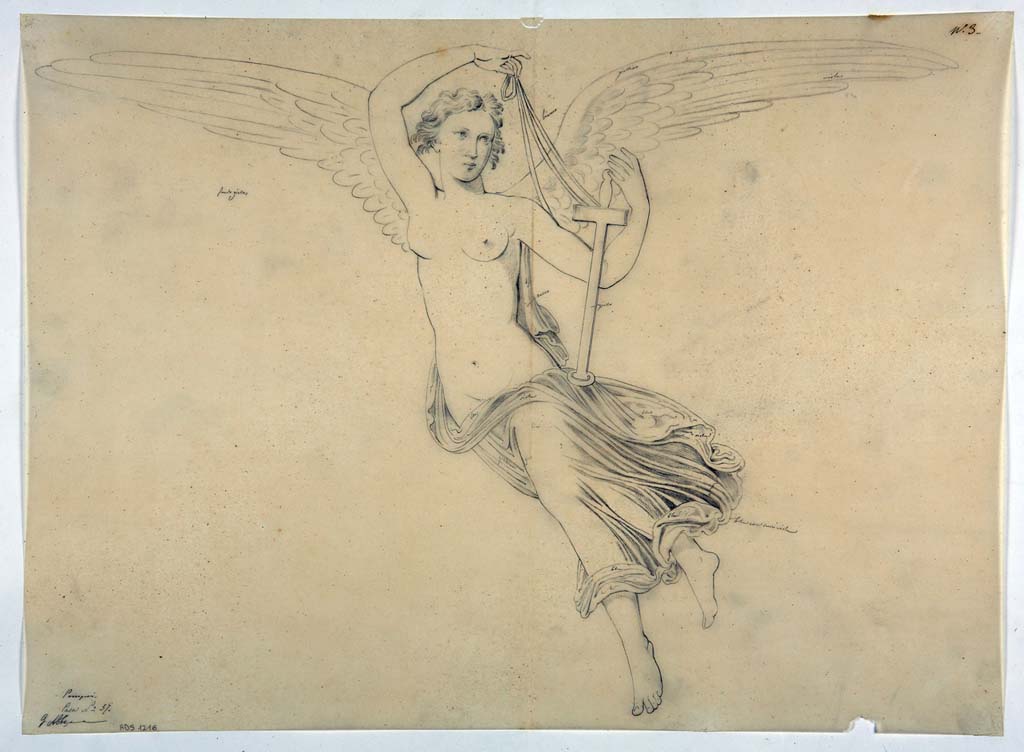
VI.1.25 Pompeii.
Preliminary
drawing by Giuseppe Abbate, of Vittoria with sword, provenanced from south wall
of peristyle 31.
Now in Naples Archaeological Museum. Inventory number ADS 1216.
Photo © ICCD. https://www.catalogo.beniculturali.it
Utilizzabili alle
condizioni della licenza Attribuzione - Non commerciale - Condividi
allo stesso modo 2.5 Italia (CC BY-NC-SA 2.5 IT)
See Helbig, W., 1868. Wandgemälde der vom Vesuv verschütteten Städte Campaniens. Leipzig: Breitkopf und Härtel, (911).
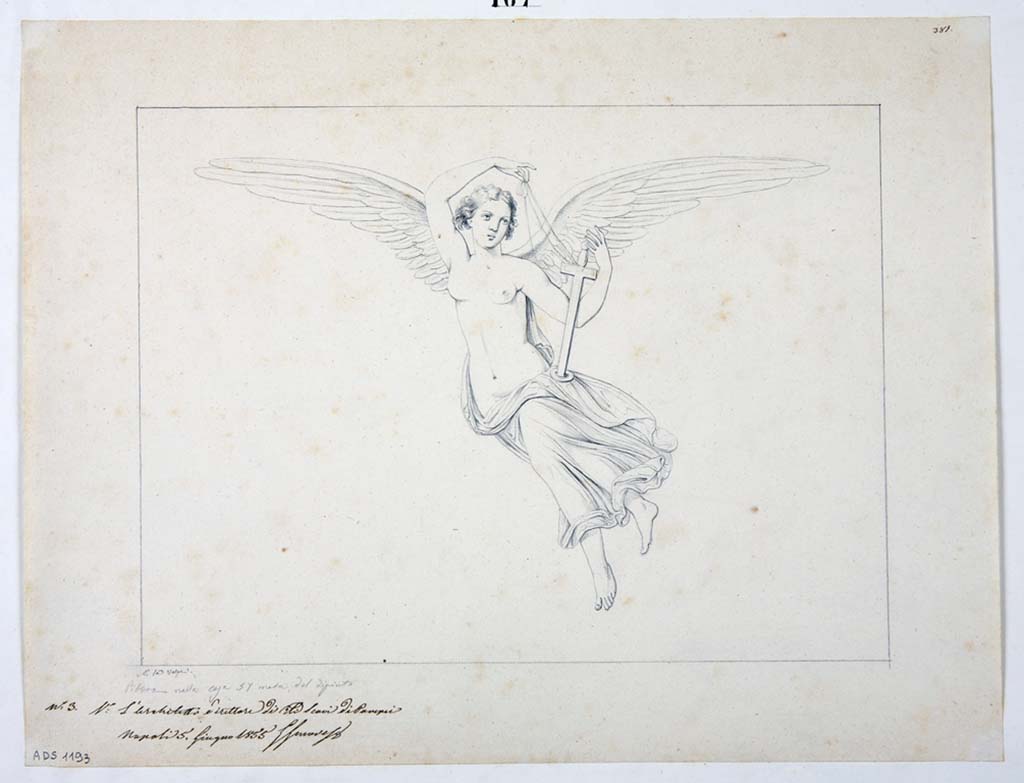
VI.1.25
Pompeii. Drawing by Nicola La Volpe, 1855, of Nike in flight with sword in left
hand, from south wall of peristyle 31.
Now in Naples Archaeological Museum. Inventory number ADS 1193.
Photo © ICCD. https://www.catalogo.beniculturali.it
Utilizzabili alle
condizioni della licenza Attribuzione - Non commerciale - Condividi
allo stesso modo 2.5 Italia (CC BY-NC-SA 2.5 IT)
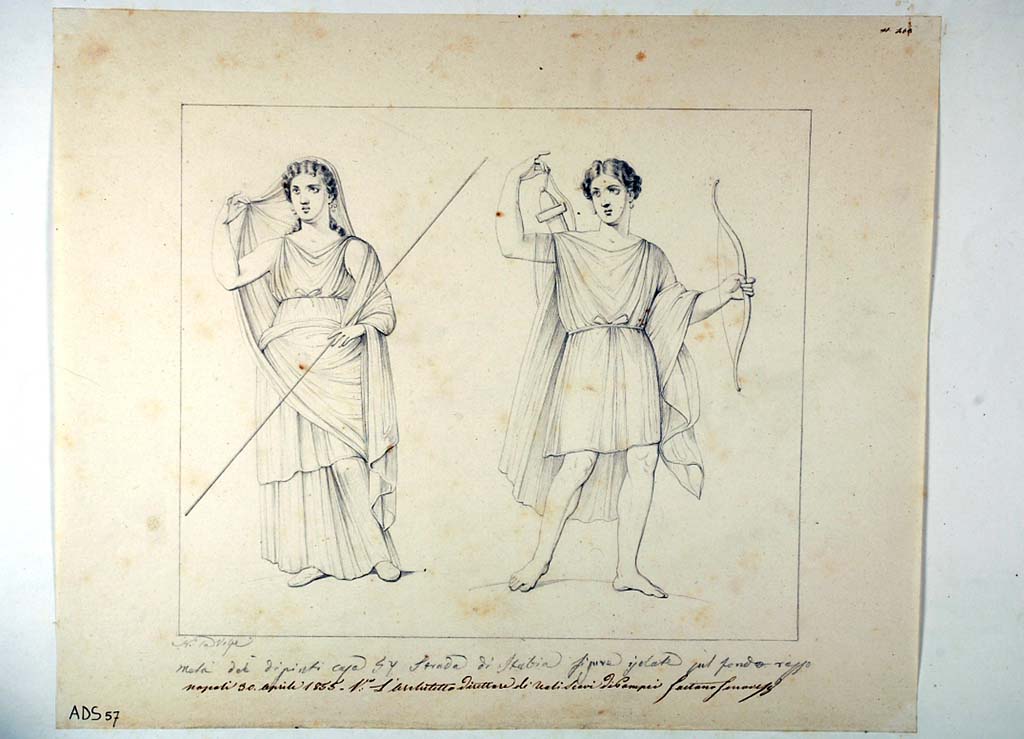
VI.1.25
Pompeii. Drawing by Nicola La Volpe, April 1855, of Leto and Artemis (Helbig
170 and 238) on a red background, from peristyle 31.
These painted
figures were not preserved.
Now in Naples Archaeological Museum. Inventory number ADS 57.
Photo © ICCD. https://www.catalogo.beniculturali.it
Utilizzabili alle
condizioni della licenza Attribuzione - Non commerciale - Condividi
allo stesso modo 2.5 Italia (CC BY-NC-SA 2.5 IT)
See Helbig, W.,
1868. Wandgemälde der vom Vesuv
verschütteten Städte Campaniens. Leipzig: Breitkopf und Härtel, (170 and 238)
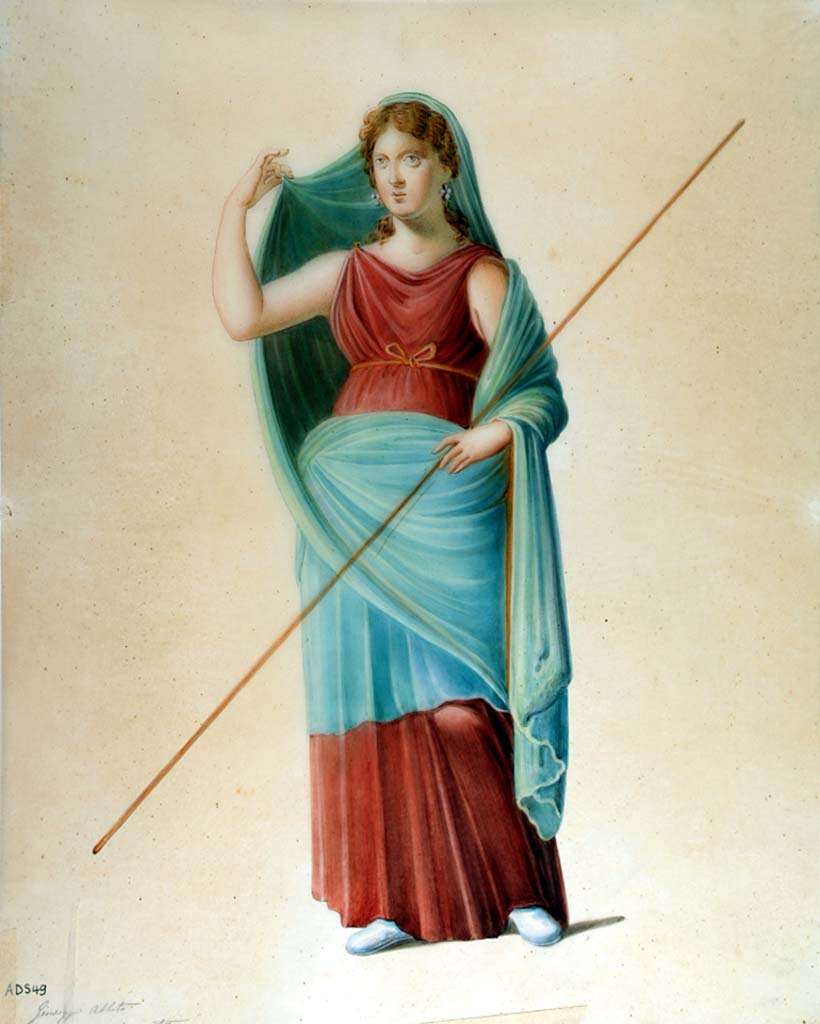
VI.1.25
Pompeii. Painting by Giuseppe Abbate, of the cloaked female figure of the
Bacchante Leto, from the south wall of peristyle 31.
Now in Naples Archaeological Museum. Inventory number ADS 49.
Photo © ICCD. https://www.catalogo.beniculturali.it
Utilizzabili alle
condizioni della licenza Attribuzione - Non commerciale - Condividi
allo stesso modo 2.5 Italia (CC BY-NC-SA 2.5 IT)
See Helbig, W.,
1868. Wandgemälde der vom Vesuv verschütteten
Städte Campaniens. Leipzig:
Breitkopf und Härtel, (170).
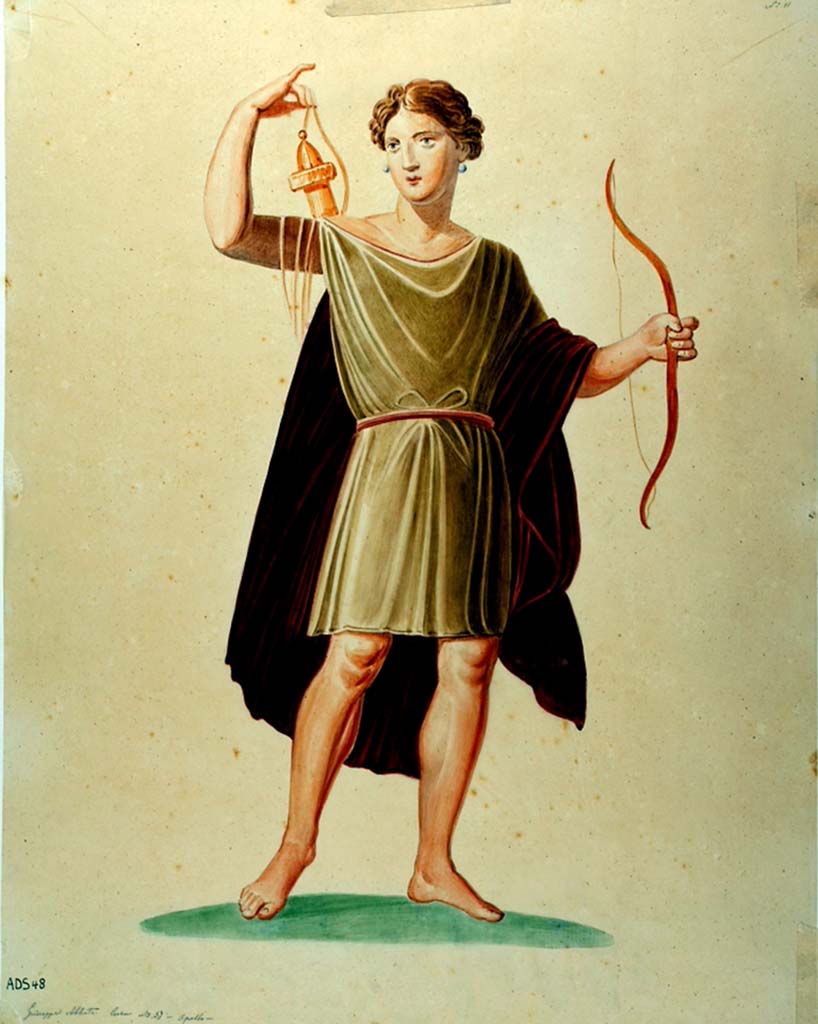
VI.1.25
Pompeii. Painting by Giuseppe Abbate, of Artemis with bow and arrow, from south
wall of peristyle 31.
Now in Naples Archaeological Museum. Inventory number ADS 48.
Photo © ICCD. https://www.catalogo.beniculturali.it
Utilizzabili alle
condizioni della licenza Attribuzione - Non commerciale - Condividi
allo stesso modo 2.5 Italia (CC BY-NC-SA 2.5 IT)
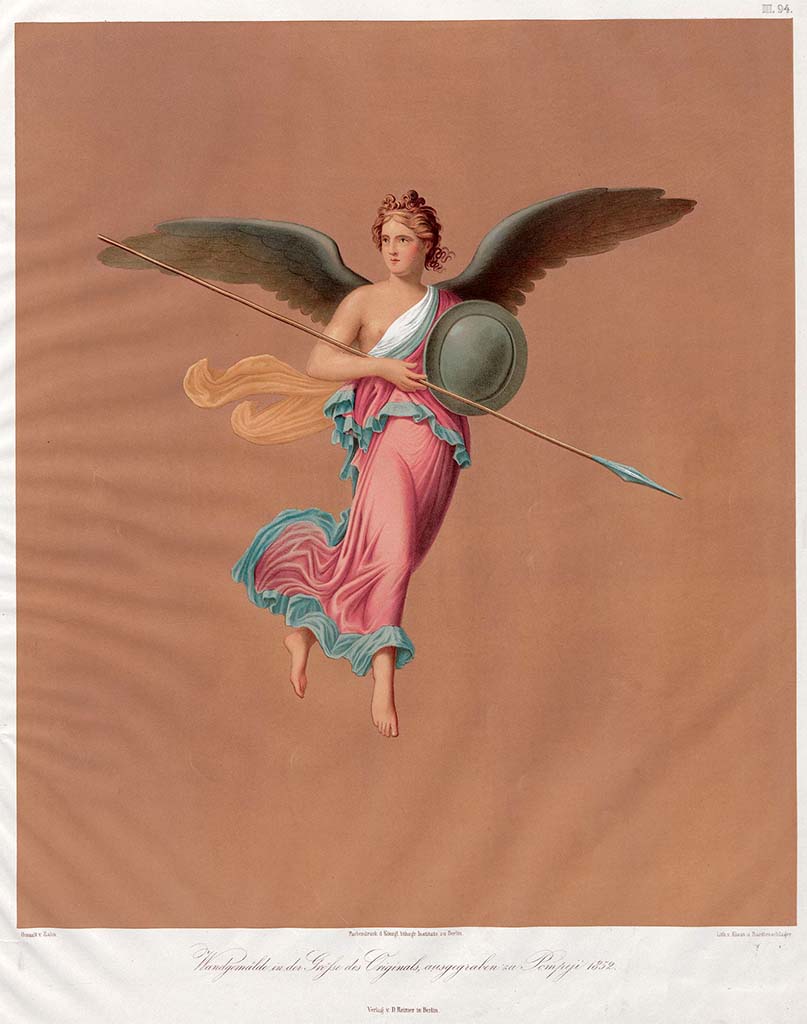
VII.1.25 Pompeii. Pre-September 1859. Painting by Zahn of armed Victory in flight.
See Zahn, W., 1852-59. Die schönsten Ornamente und merkwürdigsten Gemälde aus Pompeji, Herkulanum und Stabiae: III. Berlin: Reimer, taf. 94.
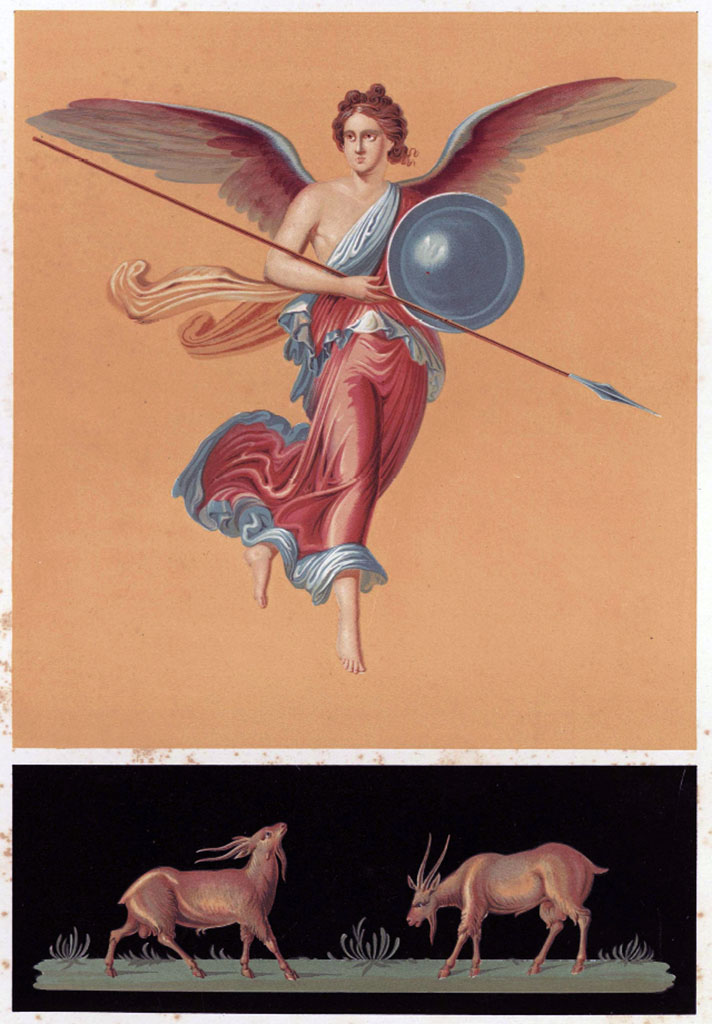
See Niccolini F,
1854. Le case ed i monumenti di Pompei:
Volume Primo. Napoli. Strada Stabiana Casa No. 57, Tav II.
See Carratelli,
G. P., 1990-2003. Pompei: Pitture e Mosaici: Vol. VI. Roma:
Istituto della enciclopedia italiana, p. 330.
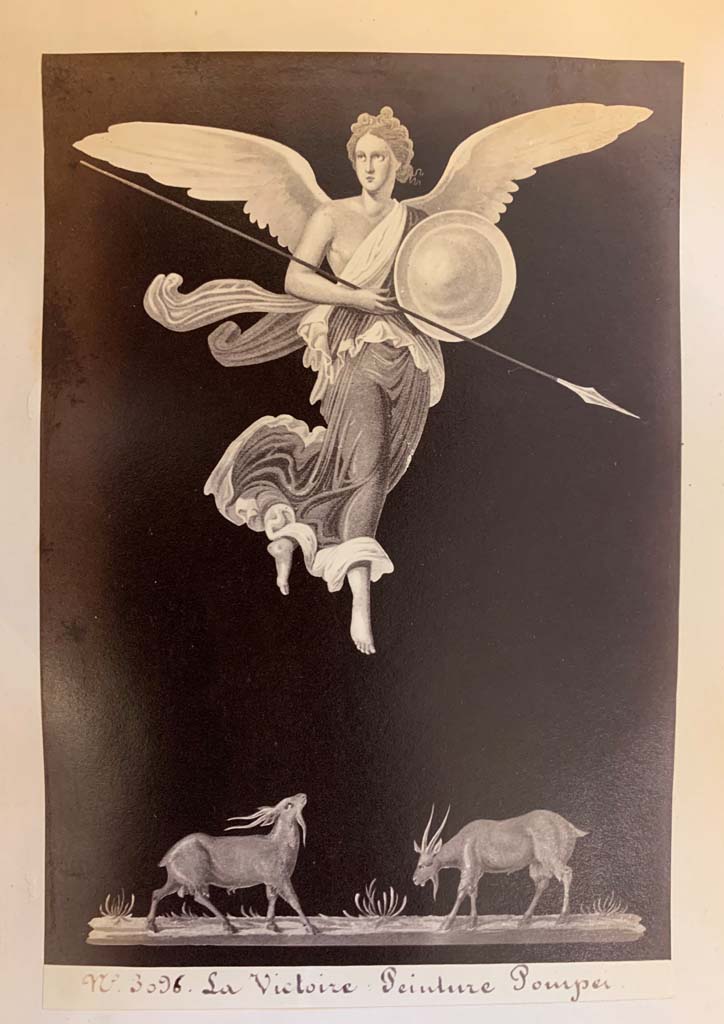
From an album
of Michele Amodio dated 1874, entitled “Pompei, destroyed on 23 November
79, discovered in 1745”.
Photo courtesy of
Rick Bauer.
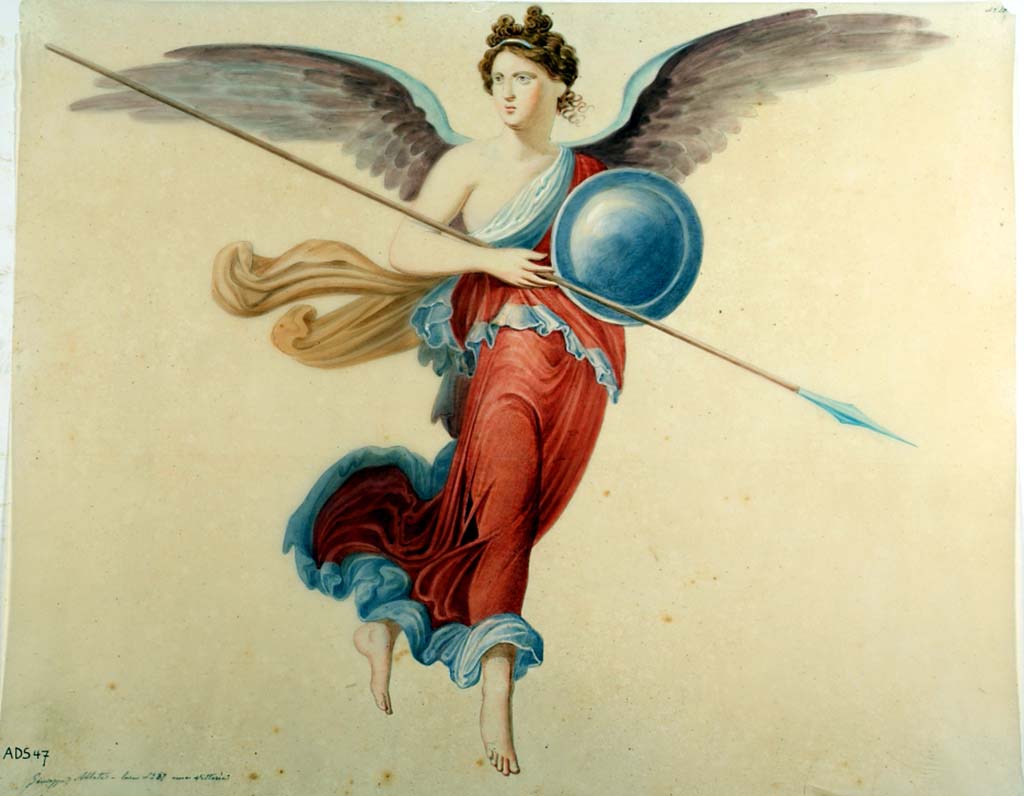
This
painting is now destroyed.
Now in Naples Archaeological Museum. Inventory number ADS 47.
Photo © ICCD. https://www.catalogo.beniculturali.it
Utilizzabili alle
condizioni della licenza Attribuzione - Non commerciale - Condividi
allo stesso modo 2.5 Italia (CC BY-NC-SA 2.5 IT)
See Helbig, W.,
1868. Wandgemälde der vom Vesuv
verschütteten Städte Campaniens. Leipzig: Breitkopf und Härtel, (907).
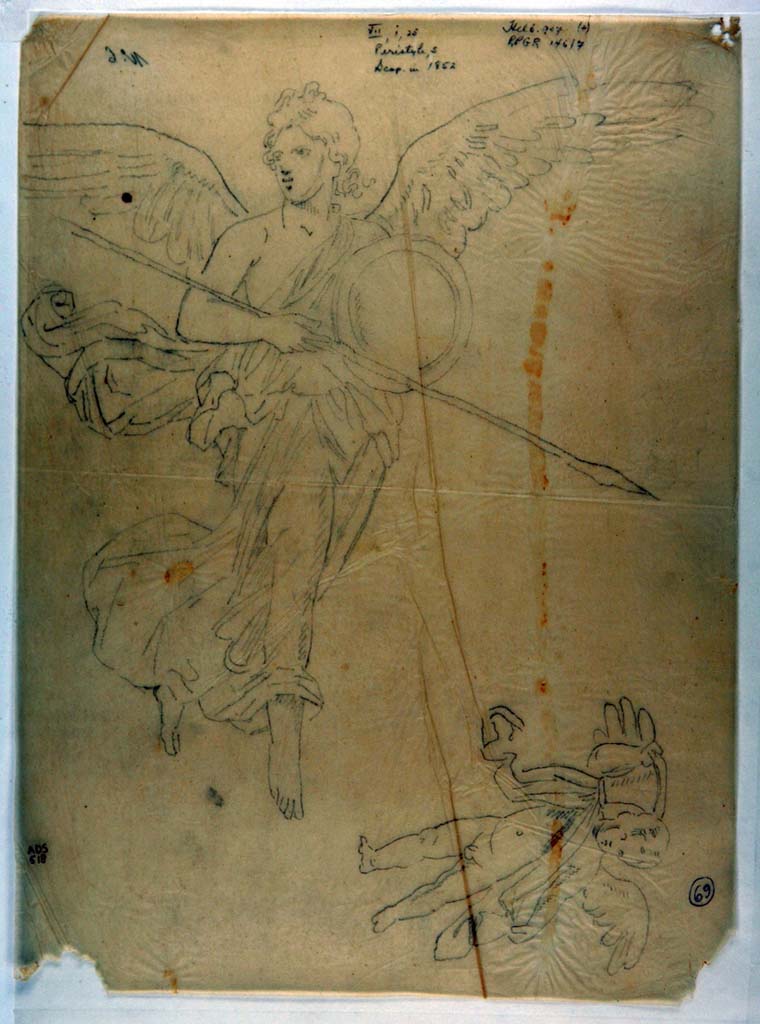
Now in Naples Archaeological Museum. Inventory number ADS 518.
Photo © ICCD. https://www.catalogo.beniculturali.it
Utilizzabili alle
condizioni della licenza Attribuzione - Non commerciale - Condividi
allo stesso modo 2.5 Italia (CC BY-NC-SA 2.5 IT)
See Helbig, W.,
1868. Wandgemälde der vom Vesuv
verschütteten Städte Campaniens. Leipzig: Breitkopf und Härtel, (907).
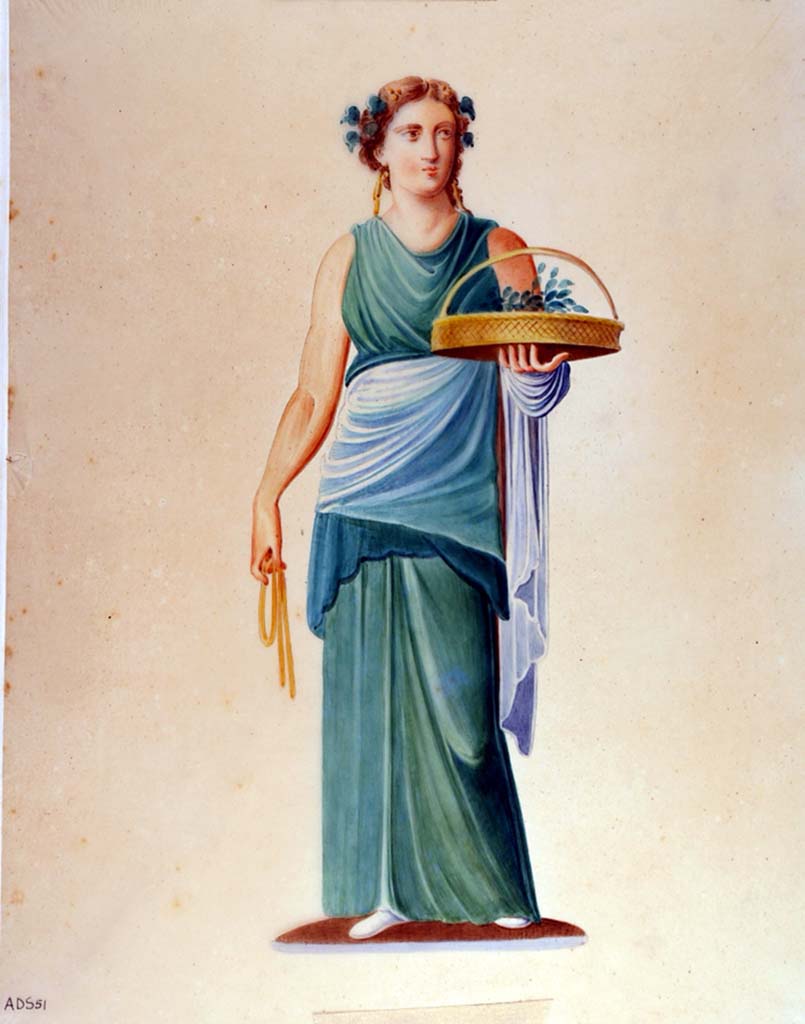
According
to PPM, no. 196, on page 331, this figure may have been part of the decoration
on the east wall of peristyle 31.
According
to Disegnatori, p.393, no. 209/210, this figure came from a room which was not
identifiable.
Now in Naples Archaeological Museum. Inventory number ADS 51.
Photo © ICCD. https://www.catalogo.beniculturali.it
Utilizzabili alle
condizioni della licenza Attribuzione - Non commerciale - Condividi
allo stesso modo 2.5 Italia (CC BY-NC-SA 2.5 IT)
See Helbig, W.,
1868. Wandgemälde der vom Vesuv verschütteten
Städte Campaniens. Leipzig:
Breitkopf und Härtel, (1803).
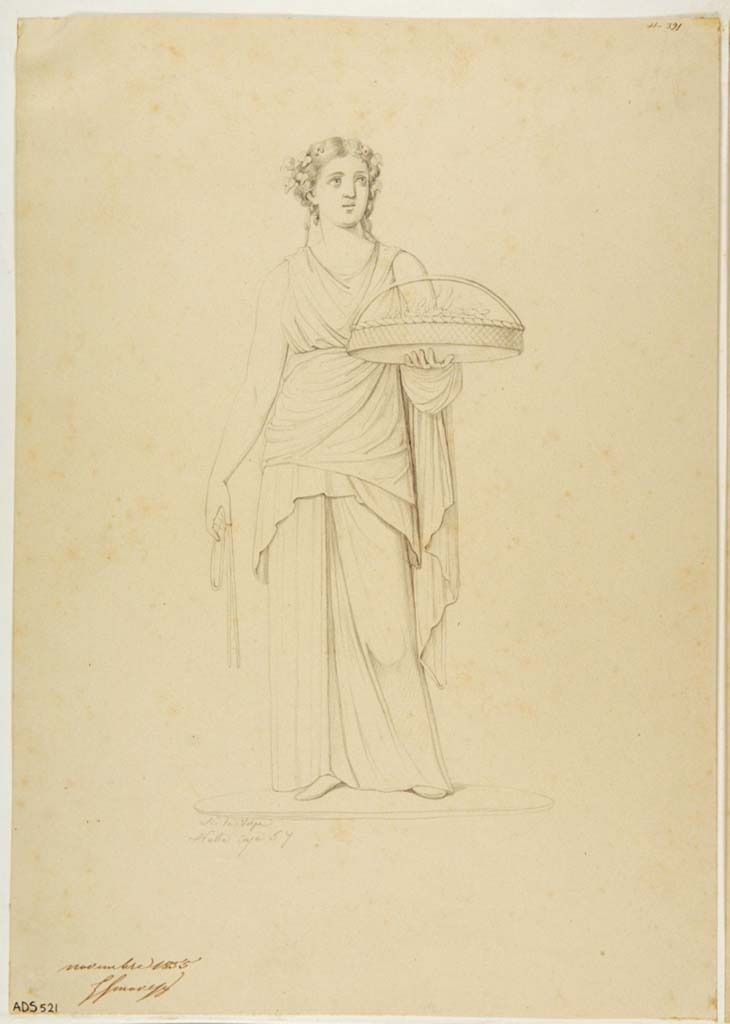
This was left
in situ, and location is no longer identifiable.
Now in Naples Archaeological Museum. Inventory number ADS 521.
Photo © ICCD. https://www.catalogo.beniculturali.it
Utilizzabili alle
condizioni della licenza Attribuzione - Non commerciale - Condividi
allo stesso modo 2.5 Italia (CC BY-NC-SA 2.5 IT)
See Helbig, W.,
1868. Wandgemälde der vom Vesuv
verschütteten Städte Campaniens. Leipzig: Breitkopf und Härtel, (1803).
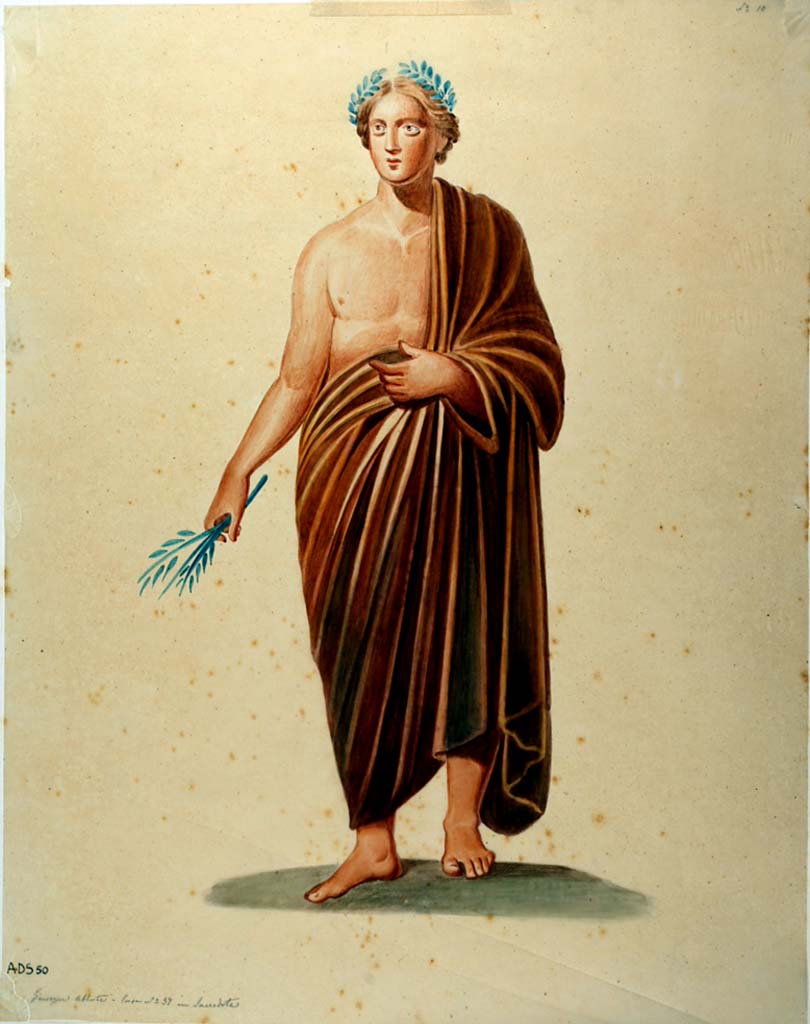
This figure may have been seen on the west wall of the peristyle 31.
Now in Naples Archaeological Museum. Inventory number ADS 50.
Photo © ICCD. https://www.catalogo.beniculturali.it
Utilizzabili alle
condizioni della licenza Attribuzione - Non commerciale - Condividi
allo stesso modo 2.5 Italia (CC BY-NC-SA 2.5 IT)
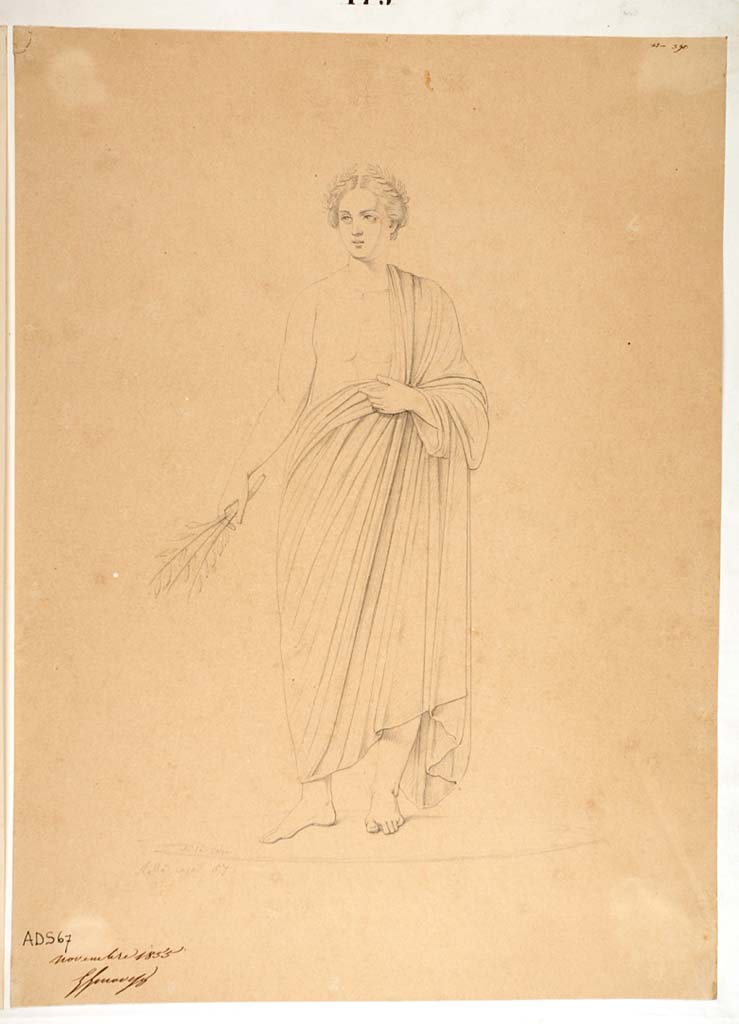
Now in Naples Archaeological Museum. Inventory number ADS 67.
Photo © ICCD. https://www.catalogo.beniculturali.it
Utilizzabili alle
condizioni della licenza Attribuzione - Non commerciale - Condividi
allo stesso modo 2.5 Italia (CC BY-NC-SA 2.5 IT)
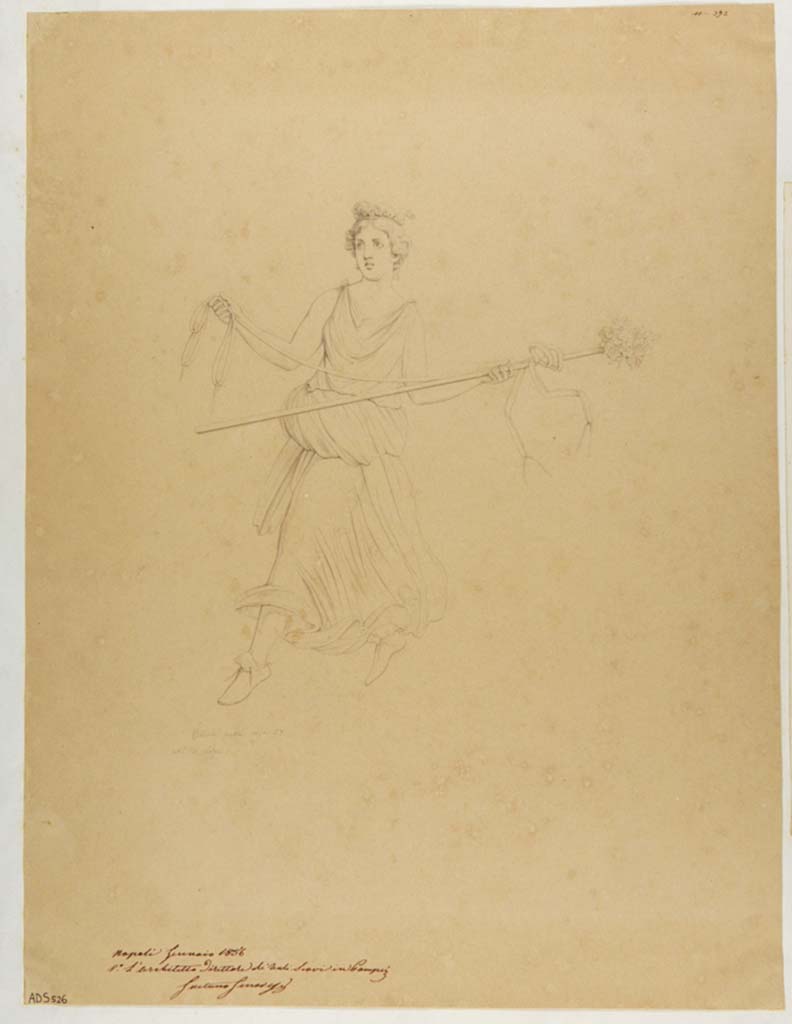
This would
have probably been seen on the west wall. Now in Naples Archaeological
Museum. Inventory number ADS 526.
Photo © ICCD. https://www.catalogo.beniculturali.it
Utilizzabili alle condizioni della licenza Attribuzione
- Non commerciale - Condividi allo stesso modo 2.5 Italia (CC BY-NC-SA 2.5 IT)
See Helbig, W.,
1868. Wandgemälde der vom Vesuv
verschütteten Städte Campaniens. Leipzig: Breitkopf und Härtel, (490).
Part 1 Part 2 Part 3 Combined plan of VII.1.25 VII.1.47 and VII.1.46 VII.1.47 VII.1.46